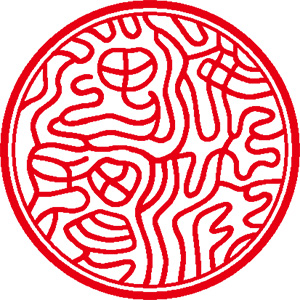The time has again arrived for our annual
... to commence Sunday, January 14th at Midnight (Sunday-Monday) Japan time (that is New York 10am, Los Angeles 7am (Sunday morning), London 3pm and Paris 4pm (Sunday afternoon)) (Aussie-Zealanders ... you figure it out! ). The ceremony will last about 1 hour, and will be visible from that time at the screen below:
). The ceremony will last about 1 hour, and will be visible from that time at the screen below:
Our 5 Preceptees, from Mexico (now living in China), Norway, the United States, the United Kingdom (now living in Japan) and Canada come together simultaneously from those places (plus several other folks undertaking Jukai with us for the second or more times), and our Preceptors Shokai, Kyonin, Jinkan and Kokuu come together from Canada, Mexico, the U.S. and the U.K., all joining in this Jukai as one, after our Jukai recipients have spent several months preparing for this day, studying the Precepts, sewing a Rakusu, weighing the place of the Buddhist Teachings in their life. As with everything at Treeleaf, all was accomplished fully online, and we now invite all our Sangha to the celebration.
Jukai literally means to receive or to undertake the Precepts. It is the ceremony both of one’s formally committing to the Buddhist Sangha and to the Practice of Zen Buddhism, and of one’s undertaking the “Sixteen Mahayana Bodhisattva Precepts” as guides for life. Traditionally for Jukai, one receives from a teacher the Rakusu, which represents the robe of the Buddha, the Kechimyaku, a written lineage chart connecting the recipient to the Buddhas and Ancestors of the past, and a “Dharma name” selected by the teacher and representing qualities of the recipient’s personality and practice.
My teacher, Nishijima Roshi, wrote this:
When a Buddhist seeks to commence upon the study of Buddhism, there is first a ceremony which should be undertaken: It is called “Jukai,” the “Receipt of the Precepts,” the ceremony in which one receives and undertakes the Precepts as a disciple of the Buddha… Master Dogen specifically left us a chapter entitled ‘”Jukai,” in which it is strongly emphasized that, when the Buddhist believer first sets out to commence Buddhist practice… be it monk, be it lay person, no matter… the initial needed steps include the holding of the ceremony of Jukai and the undertaking of the Precepts… The rationale of all of the Buddhist Precepts, the Mahayana Boddhisattva Precepts ... is as a pointing toward the best ways for us to live in this life, in this real world… how to live benefiting both ourselves and others as best we can.
WELCOME!
I, Jundo, will be present as witness to this happy event. It is an honor to experience this moment with you.
Gassho, Jundo
SatTodayLAH

Traditional "Three Treasures Seal" (三宝印) Representing the Bloodline
JUKAI CEREMONY at Treeleaf Sangha
... to commence Sunday, January 14th at Midnight (Sunday-Monday) Japan time (that is New York 10am, Los Angeles 7am (Sunday morning), London 3pm and Paris 4pm (Sunday afternoon)) (Aussie-Zealanders ... you figure it out!
 ). The ceremony will last about 1 hour, and will be visible from that time at the screen below:
). The ceremony will last about 1 hour, and will be visible from that time at the screen below:Our 5 Preceptees, from Mexico (now living in China), Norway, the United States, the United Kingdom (now living in Japan) and Canada come together simultaneously from those places (plus several other folks undertaking Jukai with us for the second or more times), and our Preceptors Shokai, Kyonin, Jinkan and Kokuu come together from Canada, Mexico, the U.S. and the U.K., all joining in this Jukai as one, after our Jukai recipients have spent several months preparing for this day, studying the Precepts, sewing a Rakusu, weighing the place of the Buddhist Teachings in their life. As with everything at Treeleaf, all was accomplished fully online, and we now invite all our Sangha to the celebration.
Jukai literally means to receive or to undertake the Precepts. It is the ceremony both of one’s formally committing to the Buddhist Sangha and to the Practice of Zen Buddhism, and of one’s undertaking the “Sixteen Mahayana Bodhisattva Precepts” as guides for life. Traditionally for Jukai, one receives from a teacher the Rakusu, which represents the robe of the Buddha, the Kechimyaku, a written lineage chart connecting the recipient to the Buddhas and Ancestors of the past, and a “Dharma name” selected by the teacher and representing qualities of the recipient’s personality and practice.
My teacher, Nishijima Roshi, wrote this:
When a Buddhist seeks to commence upon the study of Buddhism, there is first a ceremony which should be undertaken: It is called “Jukai,” the “Receipt of the Precepts,” the ceremony in which one receives and undertakes the Precepts as a disciple of the Buddha… Master Dogen specifically left us a chapter entitled ‘”Jukai,” in which it is strongly emphasized that, when the Buddhist believer first sets out to commence Buddhist practice… be it monk, be it lay person, no matter… the initial needed steps include the holding of the ceremony of Jukai and the undertaking of the Precepts… The rationale of all of the Buddhist Precepts, the Mahayana Boddhisattva Precepts ... is as a pointing toward the best ways for us to live in this life, in this real world… how to live benefiting both ourselves and others as best we can.
WELCOME!
I, Jundo, will be present as witness to this happy event. It is an honor to experience this moment with you.
Gassho, Jundo
SatTodayLAH

Traditional "Three Treasures Seal" (三宝印) Representing the Bloodline


 Thank you for being curious.
Thank you for being curious. 


 (
(
 for positive poetry 優婆塞 台 婆
for positive poetry 優婆塞 台 婆
Comment